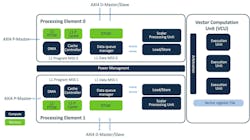DSP Handles AI-Driven Communication Tasks
Ceva's dual DSP core targets real-time applications with an artificial intelligence (AI) bent (see figure). The Ceva-XC21/XC23 cores incorporate two DSP engines and a share vector unit.
The Ceva-XC23 DSP has a smaller footprint and delivers 2.4X the performance (5.14 CoreMark/MHz) of the company's previous-generation Ceva-XC architecture. It can handle 4G, 5G, and 5G-Advanced NR chores, including supporting ultra-reliable, low-latency communication (uRLLC), while providing AI support.
The contention-free multithread, dual-core DSP is augmented by a 512-bit, SIMD vector unit. The 128 16-bit MACs support INT8/16/32 data types as well as half, single, and double precision floating-point values. The DSP employs a nine-issue VLIW instruction-set architecture supported by an optimizing LLVM C compiler.
About the Author
William G. Wong
Senior Content Director - Electronic Design and Microwaves & RF
I am Editor of Electronic Design focusing on embedded, software, and systems. As Senior Content Director, I also manage Microwaves & RF and I work with a great team of editors to provide engineers, programmers, developers and technical managers with interesting and useful articles and videos on a regular basis. Check out our free newsletters to see the latest content.
You can send press releases for new products for possible coverage on the website. I am also interested in receiving contributed articles for publishing on our website. Use our template and send to me along with a signed release form.
Check out my blog, AltEmbedded on Electronic Design, as well as his latest articles on this site that are listed below.
You can visit my social media via these links:
- AltEmbedded on Electronic Design
- Bill Wong on Facebook
- @AltEmbedded on Twitter
- Bill Wong on LinkedIn
I earned a Bachelor of Electrical Engineering at the Georgia Institute of Technology and a Masters in Computer Science from Rutgers University. I still do a bit of programming using everything from C and C++ to Rust and Ada/SPARK. I do a bit of PHP programming for Drupal websites. I have posted a few Drupal modules.
I still get a hand on software and electronic hardware. Some of this can be found on our Kit Close-Up video series. You can also see me on many of our TechXchange Talk videos. I am interested in a range of projects from robotics to artificial intelligence.


